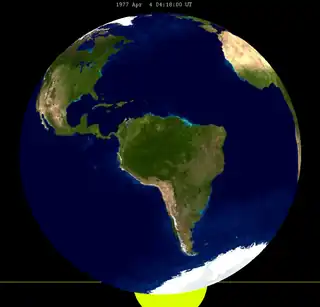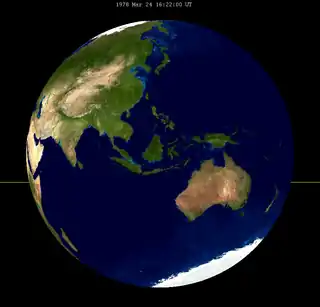| Partial eclipse | |||||||||||||
| Date | 13 March 1979 | ||||||||||||
|---|---|---|---|---|---|---|---|---|---|---|---|---|---|
| Gamma | 0.52537 | ||||||||||||
| Magnitude | 0.85377 | ||||||||||||
| Saros cycle | 132 (28 of 71) | ||||||||||||
| Partiality | 197 minutes, 40.7 seconds | ||||||||||||
| Penumbral | 350 minutes, 42.8 seconds | ||||||||||||
| |||||||||||||
A partial lunar eclipse took place on Tuesday, March 13, 1979, the first of two lunar eclipses in 1979. The Moon was strikingly shadowed in this deep partial eclipse which lasted 3 hours, 17 minutes and 40.6 seconds, with 85.377% of the Moon in darkness at maximum.
This event followed the total solar eclipse of February 26, 1979.
Visibility
It was completely visible in east in North America, South America, Europe, Africa, Asia and west in Australia, seen rising over the Americas and setting over Asia and Australia.

Related lunar eclipses
Eclipses in 1979
- A total solar eclipse on Monday, 26 February 1979.
- A partial lunar eclipse on Tuesday, 13 March 1979.
- An annular solar eclipse on Wednesday, 22 August 1979.
- A total lunar eclipse on Thursday, 6 September 1979.
Lunar year series
| Lunar eclipse series sets from 1977–1980 | ||||||||
|---|---|---|---|---|---|---|---|---|
| Ascending node | Descending node | |||||||
| Saros | Date Viewing |
Type Chart |
Gamma | Saros | Date Viewing |
Type Chart |
Gamma | |
| 112 | 1977 Apr 04 |
Partial |
−0.91483 | 117 | 1977 Sep 27 |
Penumbral |
1.07682 | |
| 122 | 1978 Mar 24 |
Total |
−0.21402 | 127 | 1978 Sep 16 |
Total |
0.29510 | |
| 132 | 1979 Mar 13 |
Partial |
0.52537 | 137 | 1979 Sep 06 |
Total |
−0.43050 | |
| 142 | 1980 Mar 01 |
Penumbral |
1.22701 | 147 | 1980 Aug 26 |
Penumbral |
−1.16082 | |
| Last set | 1976 May 13 | Last set | 1976 Nov 06 | |||||
| Next set | 1981 Jan 20 | Next set | 1980 Jul 27 | |||||
Saros series
Lunar saros series 132, repeating every 18 years and 11 days, has a total of 71 lunar eclipse events including 44 umbral lunar eclipses (32 partial lunar eclipses and 12 total lunar eclipses).
| Greatest | First | |||
|---|---|---|---|---|
 The greatest eclipse of the series will occur on 2123 Jun 9, lasting 106 minutes.[1] |
Penumbral | Partial | Total | Central |
1492 May 12 |
1636 Aug 16 |
2015 Apr 4 |
2069 May 6 | |
| Last | ||||
| Central | Total | Partial | Penumbral | |
2177 Jul 11 |
2213 Aug 2 |
2429 Dec 11 |
2754 Jun 26 | |
There are 11 series events between 1901 and 2100, grouped into threes (called an exeligmos), each column with approximately the same viewing longitude on earth.
| 1907 Jan 29 | 1925 Feb 8 | 1943 Feb 20 | |||
 |
 |
 |
 |
 |
 |
| 1961 Mar 2 | 1979 Mar 13 | 1997 Mar 24 | |||
 |
 |
 |
 |
 |
 |
| 2015 Apr 4 | 2033 Apr 14 | 2051 Apr 26 | |||
 |
 |
 |
 |
 |
 |
| 2069 May 6 | 2087 May 17 | ||||
 |
 |
 |
 | ||
Half-Saros cycle
A lunar eclipse will be preceded and followed by solar eclipses by 9 years and 5.5 days (a half saros).[2] This lunar eclipse is related to two total solar eclipses of Solar Saros 139.
| March 7, 1970 | March 18, 1988 |
|---|---|
 |
 |
See also
Notes
- ↑ Listing of Eclipses of series 132
- ↑ Mathematical Astronomy Morsels, Jean Meeus, p.110, Chapter 18, The half-saros
External links
- 1979 Mar 13 chart Eclipse Predictions by Fred Espenak, NASA/GSFC

_(cropped).jpg.webp)
